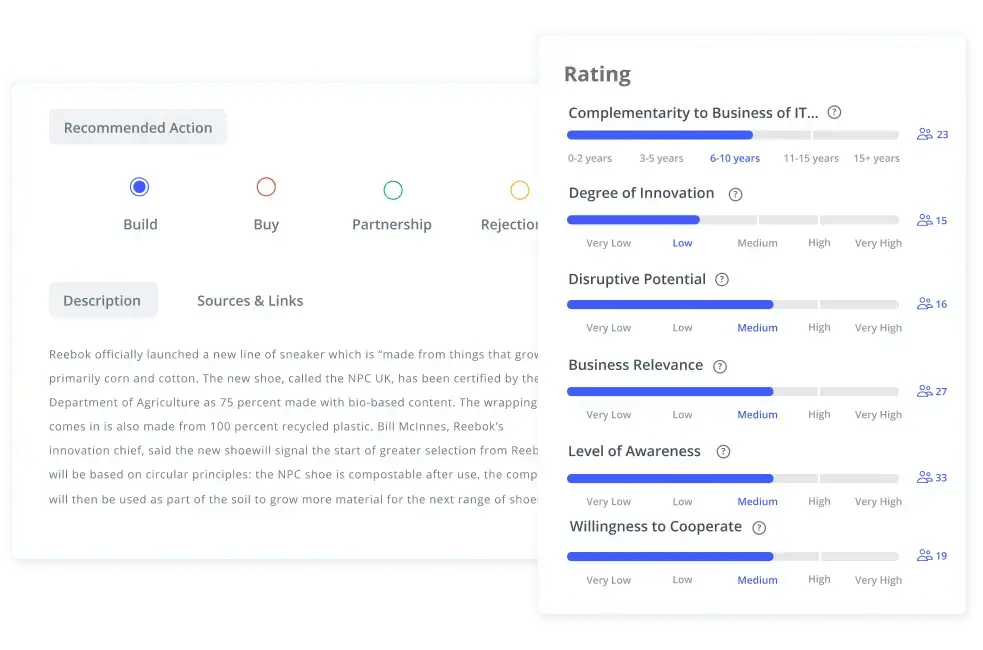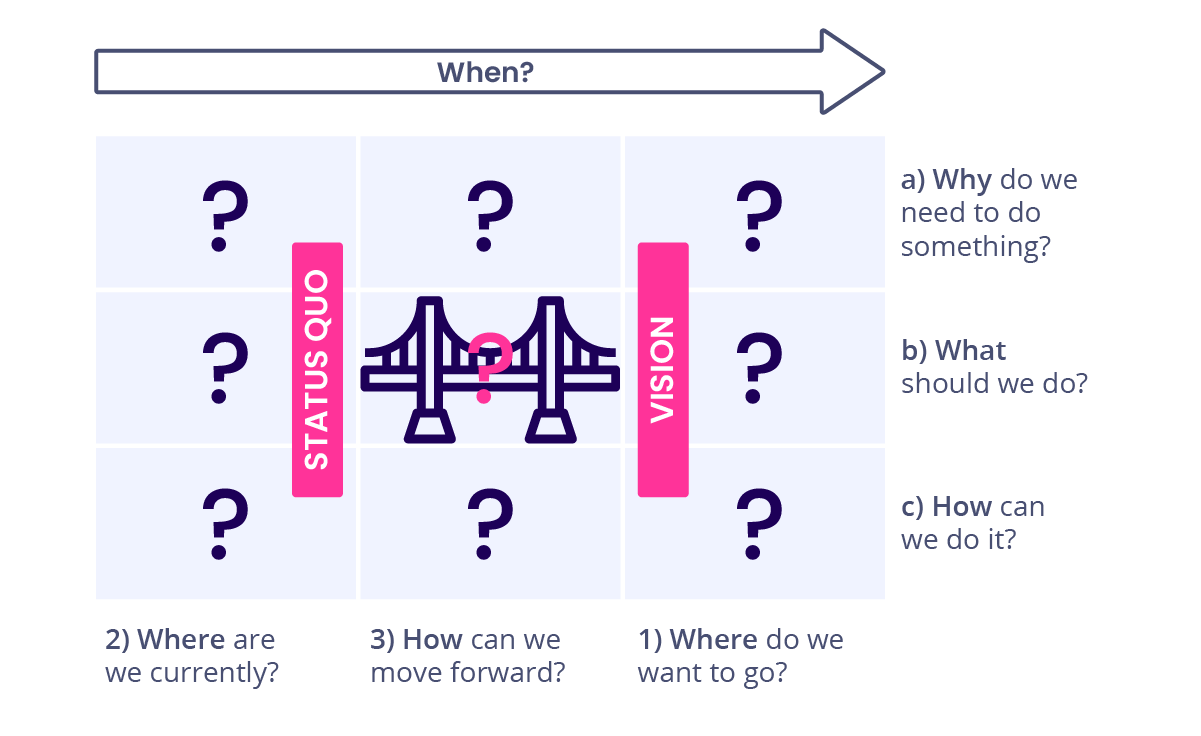 Innovation Management
Innovation Management
Strategic Planning: How to Create and Execute Strategies for Growth
Learn how to use proven strategic planning models, tools, and strategy dashboards to build and execute a winning strategy that excels business growth.
Nearly 67% of well-formulated strategies fail due to poor execution, and only 10% of organizations successfully achieve their strategic goals. In today’s boundaryless environment, companies must navigate market uncertainty, competitive pressures, and evolving customer demands with a structured approach.
Strategic planning provides a roadmap for sustainable growth, ensuring that businesses align their vision, objectives, and resources effectively. Using strategic planning frameworks, data-driven insights, and structured execution models, companies can enhance decision-making and long-term success.
This article explores essential strategic planning models, execution frameworks, and performance tracking methods, helping businesses develop and implement strategies that drive measurable results.
%20Portfolio%20Webinar%20-%20Strategy%20Roadmap.webp?width=1190&height=670&name=13)%20Portfolio%20Webinar%20-%20Strategy%20Roadmap.webp)
Strategic planning definition
Strategic planning is the process of defining an organization’s long-term goals and outlining the steps to achieve them. It provides a structured approach for decision-making, ensuring that companies align their vision with market realities and internal capabilities.
Without a clear strategic planning framework, businesses risk misallocating resources, losing focus, and failing to adapt to external changes.
What is strategic planning
What is strategic planning
At its core, strategic planning involves assessing the current state of a business, defining its future objectives, and creating a roadmap for execution. This process integrates strategic frameworks that help organizations identify market opportunities, optimize internal resources, and maintain sustainable growth.
A well-structured strategic planning framework includes defining a vision, setting strategic goals, analyzing competitors, and continuously reviewing performance. Effective strategies develop through structured planning, ensuring that every decision supports long-term objectives.
Organizations that neglect strategic planning often struggle with inconsistent direction, reactive decision-making, and inefficiencies in operations. When organizations fail, it is often due to the absence of a cohesive strategy or the inability to adapt to market changes.
Why strategic planning matters for business growth
Why strategic planning matters for business growth
Strategic planning is essential for business growth because it provides clarity, minimizes risks, and ensures that companies proactively address market challenges. Without a defined plan, businesses may expand too quickly, target the wrong audience, or invest in unsustainable initiatives.
A structured strategic planning framework helps companies navigate uncertainties, allocate resources effectively, and make informed decisions. Successful businesses use strategic frameworks like Porter’s Five Forces, SWOT analysis, and the Balanced Scorecard to assess market conditions and internal strengths.
These tools enable organizations to anticipate shifts in customer demand, competitive threats, and technological advancements. When strategies develop based on data and structured planning, businesses can scale efficiently and sustain long-term profitability.
How a clear business direction leads to competitive advantage
How a clear business direction leads to competitive advantage
A clear business direction ensures that every organization's mission aligns with its overall objectives. Companies with a well-defined strategy can differentiate themselves in the marketplace, attract the right customers, and ensure ongoing processes.
Popular strategic planning models help guide businesses in choosing whether to compete on cost, differentiation, or market specialization. For example, companies pursuing a cost leadership strategy must focus on operational efficiency and supply chain optimization.
Businesses that follow a differentiation strategy invest in innovation, branding, and customer experience. Without a clear direction, organizations struggle to align teams and efforts, making them vulnerable to external disruptions.
Strategic planning vs. business strategy
Strategic planning vs. business strategy: Understanding the difference
While strategic planning and business strategy are closely related, they serve different purposes. Strategic planning focuses on the structured process of setting goals, aligning resources, and defining execution plans. It provides one strategic planning model for how the company plans to grow, expand, or optimize operations.
In contrast, business strategy refers to the specific tactics and competitive approaches each division and team uses to achieve the overaching goals. A unified strategic management ensures that all tactics align with the organization’s vision, mission, and market position.
When companies fail to integrate strategic management with their business operations, they risk misalignment and inefficient resource utilization. Organizations fail when they lack a clear framework for decision-making, making them reactive rather than proactive in a competitive environment.
By using structured strategic frameworks, businesses can align their vision with actionable plans, ensuring long-term success and resilience in dynamic markets.
Key elements of an effective strategic plan
An effective strategic plan provides a clear direction for a company’s growth, ensuring that decisions align with long-term goals.
It combines vision, strategic objectives, customer insights, competitive positioning, and resource optimization to drive success.
Defining vision, strategic objectives, and milestones
A strong strategic planning process begins with a clear vision statement, defining what the organization aims to achieve in the long run. The organization's goals translate this vision into measurable targets, guiding the own organization toward common goals.
Setting milestones helps the entire organization streamlining processes and adjust strategies when necessary, ensuring agility in execution.
Understanding customer needs and the competition
To remain competitive, companies must continuously analyze customer needs and industry trends. By using strategic planning models, businesses can evaluate market dynamics, emerging opportunities, and competitive pressures.

Porter’s Five Forces and SWOT analysis help companies identify their strengths and gaps, allowing them to develop strategies that differentiate their offerings and enhance customer value.
Leveraging core competencies and optimizing resource allocation
Successful strategic management requires leveraging core competencies to maximize efficiency and competitive advantage. The VRIO framework ensures that resources are allocated to valuable, rare, and inimitable capabilities that drive growth.
By integrating strategic planning models into decision-making, businesses create structured, adaptable strategies that enhance long-term performance and market leadership.
Strategic planning models
Strategic planning requires structured decision-making to define growth opportunities, manage risks, and allocate resources effectively.
Strategic planning models like Porter’s Generic Strategies, Ansoff’s Growth Matrix, Blue Ocean Strategy, BCG’s Growth-Share Matrix, and McKinsey’s Three Horizon Model help businesses shape their competitive advantage and long-term strategy.
Porter’s generic strategies: Niche, cost leadership, and differentiation
Porter’s model helps companies decide whether to compete on cost, differentiation, or niche markets.
Cost leadership prioritizes efficiency in internal processes, helping businesses like Walmart scale through streamlined operations. Differentiation drives innovation and branding, as seen in Apple’s premium customer experience. Niche strategies allow businesses to target specialized customer segments, ensuring competitive strength in focused markets.
Ansoff's growth matrix: Market expansion and product expansion
For businesses planning growth strategies, Ansoff’s Growth Matrix provides one of the most known strategic frameworks for plan expansion.
%20Innovation%20ambition%20matrix.webp?width=850&height=917&name=6)%20Innovation%20ambition%20matrix.webp)
It helps organizations with strategic management of innovation activities and decide whether to expand within their current market, develop new products, or enter entirely new industries.
Blue ocean strategy
Blue Ocean Strategy helps businesses create uncontested market spaces rather than competing in saturated industries.
By identifying unmet opportunities with competitive analysis, companies eliminate inefficiencies and redefine customer value. This model shifts strategic planning from incremental improvements to market disruption, ensuring differentiation.

BCG's growth-share matrix
The BCG matrix helps companies adjust their product portfolios. Their positioning in terms of market growth and competitive position informs strategic management about their current and future profit expectation.
Stars require high investment, Cash Cows generate steady profits, Question Marks need evaluation, and Dogs may require divestment. This framework supports strategy execution by helping businesses optimize financial performance.
McKinsey's three horizon model
Like the BCG matrix, McKinsey’s horizon model is a portfolio planning model. It ensures businesses balance short-term operations, mid-term expansion, and long-term innovation.
Horizon 1 strategic initiatives optimize current operations Horizon 2 strategic initiatives expand into new markets or products, and Horizon 3 creates complete new busines models.

By balancing the horizons, businesses diversify and increase their chances of future success while maintaining short-term profitability.
Strategic planning frameworks and tools
Companies use strategic planning frameworks and tools to analyze weaknesses, assess competitive landscapes, align organizational goals, and track progress.
A clear strategy framework connects high-level goals with measurable actions. Without structured planning, businesses risk misalignment between vision and execution. Strategic planning models help organizations bridge this gap by defining how objectives translate into results.
The right tools (such as SWOT analysis, strategy map, balanced scorecard) provide a systematic approach to turning strategy into action while maintaining adaptability in a changing business environment.
Gap Planning: Using SWOT analysis to identify weaknesses and opportunities
SWOT analysis is one of the most widely used strategy frameworks for competitive analysis, which helps businesses assess internal and external factors. It identifies internal strengths and weaknesses and external opportunities and threats, allowing companies to understand where strategic gaps exist.
Gap planning ensures that businesses recognize areas where their internal processes, organizational goals, and financial performance may not align with market opportunities. Addressing these gaps helps prevent strategic planning failures and enhances overall organizational performance.
By leveraging SWOT analysis, companies can take proactive steps to strengthen weaknesses and capitalize on emerging trends. This ensures that business units allocate resources effectively and focus on key strategic objectives.
Porter’s Five Forces: Evaluating industry competitiveness
Using Porter’s framework, businesses can identify uncontested market spaces where they can operate with lower competitive pressure. This allows them to define an approach that enhances competitive advantage and long-term business success.
Porter’s Five Forces framework evaluates supplier and buyer power, the threat of new entrants, competitive intensity, and the risk of substitutes.
If bargaining power is high among suppliers or customers, companies may need to adjust pricing strategies, renegotiate contracts, or invest in differentiation strategies.
Strategy maps, balanced scorecards, and objectives and key results
Strategy maps provide a visual representation of how strategic objectives align across business functions. They ensure that departments work toward common goals, improving efficiency and coordination. This structured approach prevents silos and enhances cross-functional collaboration.
The balanced scorecard framework is one of the most popular strategic planning frameworks for measuring success. The balanced scorecard methodology evaluates four key areas: financial performance, customer engagement, internal processes, and innovation. Companies using the balanced scorecard ensure that their strategies balance short-term profitability with long-term growth.
Objectives and Key Results (OKRs) offer a structured method to define measurable goals. Organizations set clear objectives and track key results, ensuring continuous performance monitoring. OKRs help businesses stay agile by making strategic adjustments based on progress.
By integrating strategic planning models, businesses can align execution with long-term vision. Balanced scorecards and OKRs enhance accountability, ensuring that teams focus on actionable outcomes rather than vague aspirations.
Developing and implementing strategy roadmaps
A strategy roadmap outlines how an organization will move from strategic planning to strategy execution. It integrates goals, key results, and key activities across different teams into a structured timeline, ensuring continuous progress and oversight for the leadership team.

By outlining the growth plan and continuously refining the roadmap, businesses create internal trust and commitment and can adapt to market changes while maintaining focus on long-term growth.
Strategic planning process
An effective strategic planning process helps organizations align business strategy with market opportunities and internal strengths. By systematically evaluating external and internal factors, companies can develop clear strategic goals and execution plans.

External analysis: Know your market opportunities
Understanding market opportunities requires analyzing external factors that shape industry trends and competitive dynamics. STEEP analysis (Social, Technological, Economic, Environmental, and Political factors) helps organizations anticipate changes in their business environment. Identifying emerging trends ensures companies remain competitive and adaptable.

Additionally, using Porter’s Five Forces allows businesses to assess competitive rivalry, the bargaining power of suppliers and buyers, and threats from new entrants or substitutes. This external assessment provides a foundation for market penetration and expansion strategies.
Internal analysis: Know your core competencies
While market opportunities provide direction, long-term success depends on the potential to exploit these opportunities by leveraging the firm's core competencies.
The VRIO framework (Value, Rarity, Imitability, and Organization) helps evaluate an organization’s core competencies and strategic value.
-
Valuable: Does the competency create value for customers?
-
Rare: Is it unique in the industry?
-
Inimitable: Can competitors easily replicate it?
-
Organized: Can the company effectively use and scale it?
By analyzing resource allocation and internal capabilities, businesses can define their competitive advantage and avoid a strategic planning gap between market potential and execution ability.
Strategy visualization: Outline capability and market development plans
Combining core competencies and market opportunities leads to an organization’s possible direction and strategic objectives. The intersection of these two elements helps businesses clarify where they should compete, invest, and innovate.

Once the strategic direction is defined, companies must combine their prioritized strategic objectives with concrete actions and tasks that guide execution. This framework outlines areas to invest in and about internal capabilities that need to be built and do not yet align with market demands.
This combination of objectives and tasks must be translated into a strategy roadmap which is the visual representation of the strategy. The strategy roadmap provides clarity on what needs to be done and when to reach the business goals.
Strategy development cycle and routines
To keep strategy execution on track, companies must build a strong governance framework. The governance framework includes different meeting types that analyze the performance, steer corrections, and make new plans.
Organizations typically set long-term strategic frameworks through annual planning cycles, where leadership establishes major priorities and investments.
To ensure flexibility, businesses conduct quarterly reviews where teams assess progress against measurable goals and adjust tactics in response to internal challenges or shifting market conditions. These reviews ensure business success by keeping the company agile and responsive to new opportunities.
Today, strategy software supports the strategic planning process and allows for real time updates and alerts. Strategy software also provides alignment across all departments, ensuring that business strategy, resource allocation, and organizational values remain synchronized.
Companies that support their strategy with software and embed it into routine processes create a culture of continuous improvement, ensuring sustained growth and competitive positioning.
Strategy management and KPI tracking
Effective strategy management ensures that organizations successfully execute their strategic planning efforts. It involves translating high-level goals into actionable steps while continuously monitoring performance.
One of the major challenges businesses face is maintaining focus and adapting to external factors that influence operations. Without a continuous strategy monitoring approach, even the best plans can fail due to misalignment or lack of execution.
A well-defined alignment strategic planning model connects business objectives with measurable outcomes. Key Performance Indicators (KPIs) help companies measure progress, ensuring that task delivery stays on track. By ensuring progress and operational efficiency, businesses can make data-driven adjustments to improve results.
Dashboards play a crucial role in strategy control, providing real-time insights into KPIs. They enable leadership teams to monitor emerging market shifts, identify execution bottlenecks, and respond to changes in the business environment.

Accessing data on-demand through interactive dashboards improves decision-making, ensuring that adjustments are made proactively rather than reactively. By continuously reviewing performance metrics, businesses maintain alignment between strategy and execution, improving long-term success and adaptability in strategic planning.
Strategy development examples from practice
Strategy development comes to life through real-world application. The following examples of Amazon and IKEA illustrate how they structure and execute their strategic planning. It informs about the governance structure, meeting types and cadence, and decision points.
Amazon
Amazon: Strategy building through data-driven planning & agile review cycles
Amazon follows a long-term strategic vision, but its planning is highly agile, iterative, and data-driven. Instead of traditional multi-year plans, Amazon relies on continuous strategy refinement based on data and customer insights.
Every year at Amazon, senior leaders gather for the annual strategic planning meeting, a process shaped by data, not opinions. Teams prepare by writing six-page memos These memos guide discussions on long-term growth, investment allocation, and market expansion, setting priorities for AWS, Prime, and Retail.
Every six months, business units revisit their roadmaps, operational challenges, and competitive threats. These reviews ensure that Amazon stays aligned with evolving customer trends and market dynamics.
At the weekly business review (WBRs), leadership analyzes KPIs like Prime retention, fulfillment speed, and AWS uptime. Teams make data-driven decisions to refine execution, ensuring efficiency at every level.
Meanwhile, "Two-Pizza Teams" meet regularly to drive product innovation. These small, autonomous teams experiment with new features, from Alexa enhancements to logistics optimizations, ensuring Amazon stays ahead by balancing long-term vision with agile execution.
IKEA
IKEA: Structured and standardized strategic planning process
IKEA follows a structured, long-term strategic vision, balancing affordability, sustainability, and global expansion. Instead of frequent shifts, its strategy evolves through standardized planning cycles and data-driven decision-making.
Every ten years, IKEA leadership defines a long-term vision, focusing on sustainable sourcing, digital transformation, and new market expansion. This roadmap shapes investments in eco-friendly materials, e-commerce logistics, and urban store formats.
Every three years, business units refine their regional growth strategies, pricing models, and supply chain optimizations. These reviews help adjust production volumes, customer experience enhancements, and cost efficiencies.
At the annual strategic planning meeting, executives assess market trends, store performance, and sustainability metrics. Decisions focus on product design innovations, supply chain resilience, and consumer behavior shifts.
Meanwhile, quarterly business reviews bring together retail managers, logistics teams, and sustainability experts to ensure IKEA stays cost-efficient, digitally adaptive, and environmentally responsible, balancing long-term growth with real-time operational adjustments.
Build your growth strategy. Today.
The ITONICS Innovation OS is the modular and best innovation software to give teams the tools they need and foster innovation synergies across the whole organization. Our Innovation OS embodies all the essentials of the best innovation management software and covers all the application areas in one tool. It will help you to:
Eliminate information silos: Dispersed teams and disconnected data often result in missed opportunities and duplicated efforts. With ITONICS, all your new products, most innovative ideas, and market insights are centralized in one place. Create transparency and reduce inefficiencies by keeping everyone on the same page.
Turn strategy into actionable plans: Translate your strategic goals into clear tasks and timelines. Build interactive roadmaps that break down long-term objectives into specific initiatives, allocate resources effectively, and ensure every team knows its role in driving the strategy forward.
Track innovation progress across teams: Monitoring the progress of multiple innovation projects across departments isn’t easy. ITONICS provides visual dashboards and roadmapping that give you a real-time overview of ongoing projects, ensuring you can quickly address roadblocks, identify risks, and keep everything on track.
 Innovation Management
Innovation Management
 Innovation Management
Innovation Management
8 Steps to Building a Winning Digital Innovation Strategy
 Innovation Management
Innovation Management







